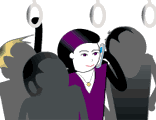What's Wrong With PHS?
Back to Contents of Issue: April 2001
|
|
|
|
by Kyoko Fujimoto |
|
 ONCE UPON A TIME in Japan, keitai, or cellphones, were considered too expensive, and PHS -- Personal Handyphone System -- mobile phones were quite popular. People used PHS phones because they were affordable, but complained about the limited service areas and poor connections when on the move. So when keitai prices dropped to a level not too much higher than PHS, most people made the switch, and PHS got stuck with a bad image -- that of being cheap and just for kids. ONCE UPON A TIME in Japan, keitai, or cellphones, were considered too expensive, and PHS -- Personal Handyphone System -- mobile phones were quite popular. People used PHS phones because they were affordable, but complained about the limited service areas and poor connections when on the move. So when keitai prices dropped to a level not too much higher than PHS, most people made the switch, and PHS got stuck with a bad image -- that of being cheap and just for kids.
The change of prefixes for PHS (070) and keitai (090) a few years ago made it clear which you used. When I was deciding whether to buy a PHS or keitai last summer, an associate asked, "Don't you feel uncomfortable telling your friends a number that begins with 070?" I almost bought a PHS just to prove that I don't care about brands; instead, I followed advice from a keitai-geek friend (who pays for several keitais and a PHS every month) and got a keitai from J-phone. I told my pals I finally had a keitai, and received lots of calls saying "Omedeto!" Coworkers 10 meters away called in to congratulate me. It was an exciting time in my life (sad, yes). At first, I loved sending email on my keitai, and I got as fast as a high-school girl. But after a few months, I was using the thing less and less, to the point where I was paying a monthly fee to carry around an unused handset. I decided to dump it ...and became one of the non-mobile again. (An unforgivable thing for a J@pan Inc editor to be, I learned.) Predictably, soon after I got rid of my first mobile, all the people who hadn't been trying to reach me suddenly desperately needed to contact me, while I was on the move. I realized it's impossible, or perhaps impermissible, to live without a mobile device in Japan now. So I started thinking all over again about which one I should use. This time I wasn't quite as excited. I signed up for the most affordable service out there: PHS by Astel. It's been a nice reminder that paying less doesn't always mean getting less.
In fact, what I've found is that for living in Tokyo and other big cities around Japan, it's often better to have PHS because of all the underground shopping malls and subway stations. Another plus is PHS's high-speed transmission -- either 32 or 64 Kbps, and DDI Pocket will soon offer 128 Kbps. Most keitai are still limited to 9.2 Kbps. Because of this speed, a lot of the cooler non-phone mobile devices in Japan are based on PHS. P-in-Comp@ct is a little combination PHS and modem from DoCoMo that can be inserted into the Type II slot of a PDA. Sigmarion, probably the most affordable full-keyboard WinCE handheld, and Eggy, a Net-capable board with a digital camera installed, can both be used with P-in-Comp@ct or another PHS connection. Fujitsu last year released a notebook PC with PHS (by DDI Pocket) modem already installed. DDI Pocket also has a combination PHS/modem called C@rd-H" 64 that can be directly inserted into your PC. This is cool stuff, but it's getting overlooked because of all the i-mode hype. i-mode may have a growing number of content and service offerings, but other keitai and PHS carriers have excellent offerings as well. A PHS service called H" (pronounced "edge," from DDI Pocket) is generating a serious buzz because it downloads music faster and cheaper. Since the H" service started in July 1999, the average age of its subscribers has gone up, according to the spokesperson at DDI Pocket, and the image of "PHS for kids" is changing. (A guy in his mid-30s told me he's thinking about leaving DoCoMo for H".) Astel offers the dot i service, which supports c-HTML and thus enables you to browse i-mode sites. (DoCoMo released in February its first Web browsing PHS.) The dot i email function is especially appealing because you can use a regular ISP supporting POP3/SMTP. You can't do this with i-mode or any other keitai/PHS services. The media keeps focusing on i-mode and other keitai services. But don't forget PHS. When I got my PHS, I thought I could always switch back to a keitai if it didn't work out. But I'm quite satisfied with the service, and I want everyone to know that PHS -- Japan's neglected mobile phone service -- not only isn't bad, it's actually pretty good. |
|
Note: The function "email this page" is currently not supported for this page.





